Soil compaction occurs when particles are compacted and the soil becomes more dense. In a normal soil, the soil particles and pore spaces are very close to 50/50, but through agricultural practices, cultivation and wheel traffic, those soil particles can become compressed closer together. In the same volume you have more soil and less pore spaces.
When soil particles (such as sand, silt and clay) and soil aggregates are forced closer together, the balance between solids, air-filled and water-filled pore spaces are dramatically altered. When the density of the soil is increased, water infiltration and root penetration are compromised. The more severe the soil compaction, the less water can infiltrate and the harder it is for roots to grow and spread.
Read Also

New high-performance forage training program to launch in 2026
A new Canadian Forage and Grasslands Asssociation high-performance forage program will be a resource for farmers, agronomists and others in the forage sector.
Farming practices to minimize compaction
There are a couple of farming practices that can contribute significantly to soil compaction — tillage and wheel traffic. When farmers cultivate fields when the soil is on the wet side, the cultivator shovels put quite a bit of pressure on the soil and a compacted zone or plow pan will form at the base of the cultivar shovel. In the case of wheel traffic compaction, the weight of the equipment, especially if the soil is wet, can actually cause compaction down to a depth of 18 to 24 inches.
To minimize soil compaction, schedule farm operations to avoid working fields or using heavy equipment on fields when the soil is wet. Ideally, the soil should break easily and crumble at the deepest depth if it is to be tilled.
Reducing or eliminating tillage will help to keep soil compaction to a minimum as every tillage pass reduces soil aggregate structure and if wet, can potentially increase soil bulk density. Farmers should also remove excess weight from their equipment and only use enough ballast to reduce wheel slippage. Another way to reduce surface pressure is by reducing tire pressure or by using lighter axle loads
Improved surface drainage can help reduce risk of being forced to work wet fields. Fields need to be handled individually to ensure that the correct drainage methods are employed for the area, the soil type and the slope of the field.
Good crop rotations can be a long-term beneficial practice that can help reduce soil compaction. Crop rotations should include deep rooting crops such as alfalfa.
Sub-soiling or ripping to alleviate soil compaction problems should be used only when soil is dry and crumbles to the tillage depth. The operating depth should be no more than a few centimeters below the zone of compaction — any deeper uses more energy and increases the potential of deeper compaction.
Be careful with deep tillage
Use deep tillage with great caution. Although deep tillage can be beneficial under specific soil conditions, its use can also have very serious negative effects on soil quality. The use of deep tillage must be considered carefully. Some potential concerns:
- Some rippers cause greater mixing of surface soil with subsoil, which results in the deterioration of soil structure, reduction in soil organic matter, reduced soil fertility and increased potential for surface soil crusting. These conditions can be much worse than minor soil compaction problems.
- Loss of plant-available moisture can occur.
- Soluble salts in subsoil can be intermixed with surface soil, increasing salt levels and reducing crop yield potential.
- Subsoiling can make the ground surface rough and lumpy and can pull rocks to the surface.
- A subsoiled field will often have a poor seedbed the following year due to an uneven and soft surface soil and reduced soil moisture conditions.
- If high or excessive amounts of moisture are received after subsoiling, the fractured soil zones can become waterlogged and unmanageable until dry.
Before attempting to deep rip a field, carefully consider the potential negative consequences. Ideally, try ripping in several test strips in a field to evaluate the benefits and risks over one or even two years before deep ripping an entire field.
Prevent soil compaction
Ideally, farmers should design their soil management and cropping practices to ensure the prevention of soil compaction:
- Use direct seeding practices to increase soil organic matter content, which will optimize soil structure.
- Reduce the potential for the development of compacted soils by eliminating cultivation and reducing traffic in fields, which will increase crop yield potential.
- Take advantage of the natural soil processes of “wetting-drying” and “freeze-thaw” cycles to minimize the effects of soil compaction.
- Use a combination of fibrous and taprooted crops in a rotation to penetrate soils, develop deep root channels and add organic matter to soil
For more information on soil compaction see Alberta Agriculture Agdex 510-1: Agricultural Soil Compaction: Causes and Management. You can find this on-line at www.agric.ab.ca, just type “510-1” into the search box.
This article originally ran in the “Prairie Steward” the newsletter of the Saskatchewan Soil Conservation Association. Learn more about the SSCA at www.ssca.ca. †















